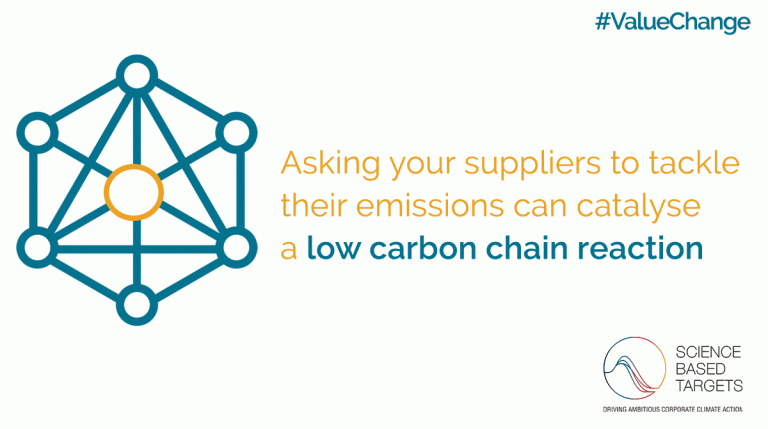
Change the chain: Setting science-based targets for your value chain
Dec 4th 2018
Large corporations have complex and extensive value chains. Often made up of tens of thousands of companies, they wrap around the globe.
In many sectors, the value chain accounts for the majority of companies’ overall greenhouse gas emissions.
These companies are effectively outsourcing their environmental impact to other companies – often in other countries – across their value chain.
The importance to tackling value chain – scope 3 – emissions
To date, most companies have focused on tackling the emissions they have direct control over. Either those under their own operational control (scope 1) or those from the purchase of electricity, heat and steam (scope 2).
And while many companies are already making significant progress towards these goals, they have the opportunity and the responsibility to do even more.
Last month, the Intergovernmental Panel on Climate Change highlighted the growing urgency to reduce emissions. To limit temperature rise to below 1.5°C and avoid the worst impacts of climate change, it warned that emissions would need to drop 45% in the next 12 years and reach net zero by 2050.
We have to do everything we can to cut emissions, as quickly as possible, and wherever possible.
The business community is responsible for the majority of global emissions, while value chain emissions account for the majority of most companies greenhouse gas emissions.
Put simply, companies can not do their share without addressing scope 3 emissions.
The complexities of addressing scope 3 emissions
The very nature of value chains is complex.
Upstream of a company’s own operations – the companies from which it buys goods and services – they could be dealing with thousands of different operators, while downstream – the use of its sold products – their customer base may be even wider.
This makes accurate and complete scope 3 emissions data notoriously hard to collect.
Meanwhile, value chains are not linear. If you were to map the operations from the largest companies within any given sector, you would find a web of overlapping value chains.
Many of these companies would sit within each other’s value chains – for example Apple outsourcing some of its manufacturing to Samsung – while the companies from which they buy, and the customers to which they sell, also have significant overlap.
As such the question of responsibility becomes unclear.
The benefits of collaborative value chain action
Yet, while this complexity creates barriers to companies addressing their scope 3 emissions, it also creates huge opportunities for collaboration and innovation.
A company may be upstream or downstream from another company depending on whose value chain you’re looking at.
Customers drive demand, which is then met by producers. A greater demand for lower carbon products and services will have producers sit up and listen.
But the opposite is also true. Producers can also create new, innovative business that can open up markets never before seen, completely shifting the way we do business, and passing these new learnings on to their customers.
Collaboration is key, and these efforts will come together in a positive feedback mechanism which will see business action cascade across their value chains and move, together, towards a low-carbon future.
Take for example, early mover HPE. The IT company’s value chain is vast. Since many companies share multiple customers, there’s an opportunity for collective action. HPE has been working to create a unified approach which will see suppliers across the sector setting science-based targets (SBTs).
By creating a cohesive framework for the industry, the company hopes to reduce the burden of duplicate data collection, provide a clear call for action, and offer guidance on methods and process for setting SBTs.
This is turn will help HPE reach their own SBT, which includes a scope 3 target to cut manufacturing-related emissions within its value chain by 15% by 2025.

Making the first steps to value chain emission reductions
When it comes to tackling their value chain emissions, companies have a range of options available to them, depending on their size and structure.
For example, companies can use their purchasing and investing power to shift action, engage with their suppliers and customers, and can use design and innovation to reduce emissions in their value chain, cut waste and build efficiency.
U.S. based Tennant Company provide cleaning products and solutions to businesses operating in six global regions. It was able to use innovation and design to support its customers to become more sustainable.
Through it’s signature product, ec-H20™ – which electrically converts tap water into a floor cleaning solution – the company helped its customer avoid more than 75,000 metric tons of CO2e.
At the same time the company generated $1.2 billion in revenue from the technology, and made progress on its scope 3 target. With as much as 68% of the company’s annual emissions falling within their value chain, tackling scope 3 emissions will be vital to its success.
While investing in smart solutions is vital, an effective approach to tackling value chain emissions starts with understanding your scope 3 inventory and putting robust and ambitious targets in place.
For furniture giant and global franchisor IKEA, mapping emissions was a critical first step to setting an ambitious target.
In spring 2017, the company developed a simulation tool to do just that. Covering 99% of its scope 3 emissions, including a focus on raw materials extraction and processing, production, customer travel, deliveries and product use, the tool was able to map it global value chain emissions and find potential for innovation within it.
The Science Based Targets initiative is on hand with resources to support a company to formulate targets to address this complex web of emissions.
Meanwhile, through our new scope 3 guidance – produced in collaboration with Gold Standard and Navigant – we aim to showcase the most effective options for addressing these emissions, and what options could provide the biggest environmental and business wins.



